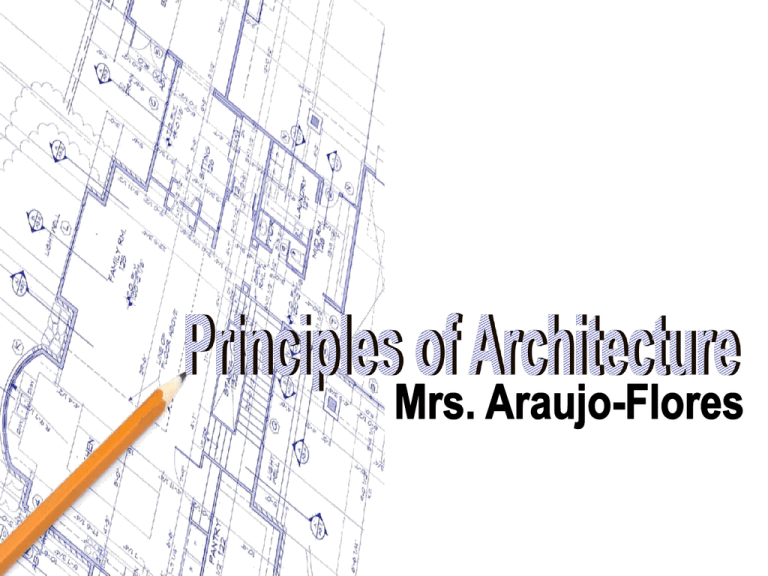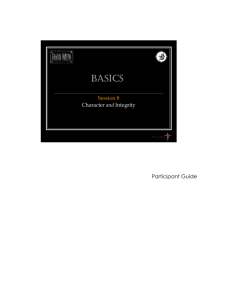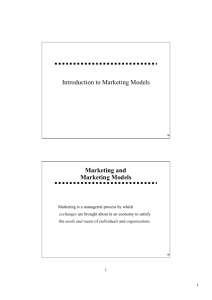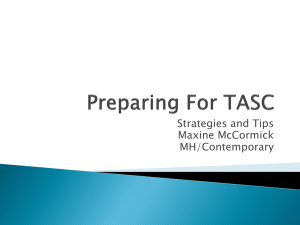Elements of Architecture: The Basics of Beautiful Design
advertisement

Objectives • You will understand that architectural design is composed of elements. • You will know the definitions of these elements. • You will be able to identify structures that illustrate these elements. Elements of Architecture: The Basics of Beautiful Design What elements and principles of architecture do architects include in the design of structures? The Basics of Architecture Structure Anything that is built or constructed and has a plan. Seagram Bldg NYC The Basics of Architecture: Basic Structures Post and Lintel Method of construction in which vertical posts support horizontal lintel, beam. Stonehenge The Basics of Architecture: Basic Structures Parthenon Columns Vertical, round pillar that supports an arch or entablature Three types of Greek Columns Doric -simple capital Ionic -scrolled capital Corinthian -fancy capital Doric Ionic Corinthian Corinthian Column Capital The Basics of Architecture: Basic Structures Colonnade Parthenon St. Peter’s Square Line of arches or columns bearing a horizontal entablature. Entablature • The parts of an order between the column capital and the roof or pediment. • It is divided into three parts: architrave, frieze, and cornice. The Basics of Architecture: Basic Structures Arch Vaulted wall opening that can span large spaces. Coliseum Pont du Gard St. Paul’s Cathedral Types of Arches The Basics of Architecture: Basic Structures • Dome • a large hemispherical roof or ceiling • arches are jointed at the top and legs form a circle • creates more expansive space inside a structure • base can be circular or angled Hagia Sophia – square base Dome of the Rock Circular Base The Basics of Architecture: Basic Structures Spire a tapering roof or pyramidal construction surmounting a tower Salisbury Cathedral - England The Basics of Architecture: Basic Structures Cantilever Horizontally projecting beam or part of a structure supported only at one end. Falling Water Cantilever The Basics of Architecture: Basic Structures • Buttress • A projecting structure for support to give stability to a loadbearing wall. • Counteracts lateral thrust. The Basics of Architecture: Basic Structures • Flying Buttress • Arch commonly seen on the exterior of Gothic cathedrals • Used to support high stone walls by transmitting force to an exterior support. • Counteracts lateral thrust. Notre Dame – Paris France Buttress Flying Buttress 1. 2. 3. 4. 5. Media or Materials -what the structure is made from Function -purpose for which the building was originally designed • The function of a building may change over time but the original purpose still dominates the design. Context • Physical • The area on which the building is constructed. • When considering the context of a building, you must also look at the environment. Japanese School • Physical Context • Construction of the tower occurred in three stages across 344 years • The tower's tilt began during construction, caused by an inadequate foundation on ground too soft on one side to properly support the structure's weight. Leaning Tower of Pisa Context • Todaji Buddhist Temple Nara, Japan All wood construction • Historical/Cultural • The time, place, and culture that influenced the creation of the building. The Elements of Architecture • Line • Where two parts come together Great Pyramid The Elements of Architecture • Color • Colors used on the interior or exterior of the building. Dome of the Rock The Elements of Architecture • Shape/Form • The outline of the building if viewed from the air AND from the ground. St. Paul’s Cathedral - aerial view Shape/Form The Elements of Architecture • Texture • How the building feels or looks • Can be the interior or exterior Guggenheim The Principles of Architecture • Space • The area in and around a building Louvre The Principles of Architecture • Balance • Distribution of weight Eiffel Towel The Principles of Architecture • Rhythm/Repetition/ Pattern • Repeated use of an element Raphael’s Loggia The Principles of Architecture • Emphasis • Calling attention to one part • This is achieved by using the elements and principles of architecture Dome of the Rock The Principles of Architecture • Variety/Contrast • the use of differing elements Villa rotunda The Principles of Architecture • Proportion • comparison of size of parts and size of the whole The Principles of Architecture • Scale • Scale-sized compared to people Pantheon - Rome The Principles of Architecture • Unity • Use of similar elements to tie the work together Leaning Tower of Pisa











